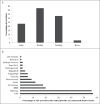Immunization attitudes and practices among family medicine providers
- PMID: 29028414
- PMCID: PMC5703405
- DOI: 10.1080/21645515.2017.1371380
Immunization attitudes and practices among family medicine providers
Abstract
Objective: To describe immunization attitudes and practices among family medicine providers across New York State.
Methods: In this cross-sectional survey study, family medicine providers across New York State completed a questionnaire to assess vaccine beliefs and barriers and immunization practices.
Statistical analysis: Descriptive statistical methods were used to define provider characteristics, knowledge and vaccine practices.
Results: Completed questionnaires from 226 family medicine providers were included for analysis. As a group, 207/218 (95%) of providers who answered the question state they always recommend standard pediatric vaccines. Of the 209 providers who answered both questions, 47 (22%) state they always recommend standard pediatric vaccines but do not always recommend HPV vaccine to eligible 11-12 year-old patients. Only 75% of providers strongly disagreed with the statement 'vaccinating adolescents against HPV increases the likelihood of unprotected sex'. Even though 178/190 (94%) and 164/188 (87%) of surveyed family medicine providers reported recommending that their pregnant patients receive influenza vaccine and Tdap vaccine, respectively, only 134/185 (72%) routinely do so in their office.
Conclusion: Most family medicine providers self-report always recommending standard pediatric vaccines, however only a minority are following ACIP recommendations. Educational sessions to update family medicine providers on ACIP recommendations and address individual provider concerns may improve provider vaccine confidence and uptake of vaccines by their patients.
Keywords: family medicine; family practice; vaccine attitudes; vaccine hesitancy.
Figures



References
-
- CDC National, regional, state, and selected local area vaccination coverage among adolescents aged 13–17 years – United States, 2015. MMWR. 2016;65:850-8. PMID:27561081 - PubMed
MeSH terms
Substances
LinkOut - more resources
Full Text Sources
Other Literature Sources
Medical
Research Materials
